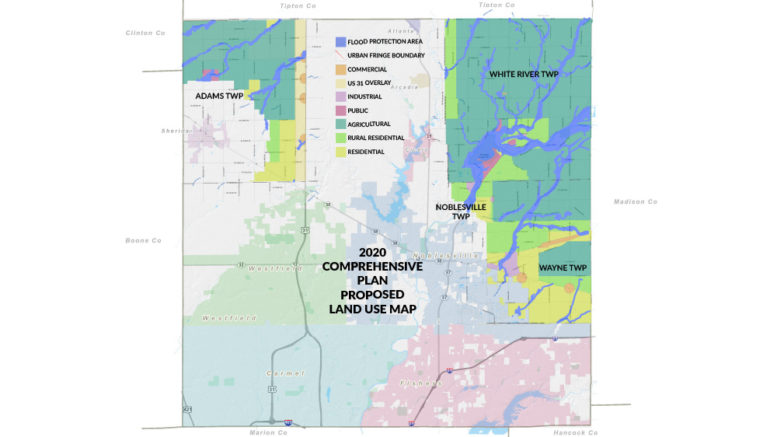Public hearing on plan adoption set for 7 p.m. tonight
By CORRIE MEYER
Editor’s note: Corrie Meyer, AICP, PLA, is the President and CEO of Carmel-based Innovative Planning, LLC.

Meyer
The Hamilton County Plan Commission embarked on a journey to update the Comprehensive Plan for the rural townships of Wayne, White River, the northeast corner of Noblesville, and Adams Township. These townships represent the jurisdiction area of the Hamilton County Plan Commission. Other townships like Jackson, Clay, and Washington are governed by other Plan Commissions.
Throughout 2020, the Plan Commission worked with a consultant team of Innovative Planning, Burke Engineering, and Peterson Architecture. Innovative Planning led the team and the Plan Commission through research, analysis, social media engagement, nine community meetings, six public presentations, and the culmination of new recommendations for the Plan Commission and townships to implement over the next 10 years.
A comprehensive plan is a long-range, all-inclusive planning document that allows the county’s vision to be strategic, thoughtful, and adopted for implementation. This document provides a foundation for all land use, transportation, and environmental policies, projects, and activities. All governing bodies of the county will refer to this plan when working on future projects.
Indiana code IC 36-7-4-500 allows Plan Commissions to adopt a comprehensive plan that is a “promotion of public health, safety, morals, convenience, order, or the general welfare and for the sake of efficiency and economy in the process of development.” By code, the plan must contain these three elements:
- A statement of objectives for the future development of the jurisdiction.
- A statement of policy for the land use development of the jurisdiction.
- A statement of policy for the development of public ways, public places, public lands, public structures, and public utilities.”
Why plan at all? There are several reasons for good planning. Planning for the future provides a framework for county leaders to implement best land use, transportation, and environment practices. A good plan is holistic, which allows for future decision making to be informed and based on factual data. It gives guidance for landowners and developers regarding what county leaders and residents want to see, and how to grow, build, and invest in the county. It provides an avenue for county planners to listen to residents and community members. A county plan will influence neighboring jurisdictions. It is mandatory in order to have zoning laws. Finally, a good plan protects property values.
The last Hamilton County Comprehensive Plan was adopted in 2006; and prior to that, 1990. The mission of today’s Comprehensive Plan is for residents and leaders of Hamilton County to shape a land use vision that strikes a healthy balance between environment, community, culture/values, and economy for the Hamilton County Plan Commission to implement over the coming decade. The goals of this planning effort were to develop a plan that is rooted in citizen input, create development strategies for the right development in the right place, and listen to leaders of Hamilton County and incorporate their vision in the plan.
This project was completed in an unprecedented time, during the COVID-19 pandemic. Innovative Planning and its team broke the project into three phases: Analysis/discovery, public engagement, and exploration. A detailed examination of existing plans, maps, and other resources were completed.
This information was used in conversations with stakeholders. Public engagement consisted of nine public meetings – three in each township, mailed and online surveys (with over 600 responses), and public presentations at Steering Committee, County Commissioners, County Council, and Plan Commission meetings. The team incorporated public ideas into concrete concepts for land use or other planning jurisdiction issues like land use, transportation, and flood resiliency.
Finally, the exploration phase consisted of in-depth research of planning trends, best practices for rurality, and reviews of peer county policies and discussions with elected/appointed officials.
Throughout the public engagement period, a vision for the townships of Adams, White River, Wayne, and northeast Noblesville emerged. The recommendations of the new Comprehensive Plan needed to (1) endorse the agrarian culture and quality of life, (2) balance current land uses and growth in a sustainable manner, (3) protect floodplains and natural resources, (4) strategically encourage economic development in business and agriculture, and (5) manage population growth by increasing clusters of population density.
The Comprehensive Plan recommendations are just that – recommendations. They are strategic initiatives that, if acted on, would accomplish the Plan Commission’s vision statements. These recommendations are not code and they are not policies that have already been adopted. They are strategic inspirations that work towards the project’s mission.
The recommendations are intended to be implemented over the next 10 years through Plan Commission zoning ordinances, future/adopted county-wide policy statements, and by influencing other governing bodies in Hamilton County, the region, and state. The 2020 Comprehensive Plan recommendations are categorized under Quality of Life, Land Use, Economic Development, Stormwater and Flooding, and Transportation.
Quality of Life
- Support population diversity.
- Promote aging in place.
- Adopt a policy that incentives development of green infrastructure.
- Invest in recreation.
- Support affordable housing options.
- Develop policies and tools to limit invasive species.
Land Use
- Preserve agricultural land, yet strategically plan for growth.
- Promote to keep active farms in agricultural use and protect jobs in the agriculture economy.
- Consolidate agricultural use districts.
- Evaluate density credit language for all agricultural zones.
- Maintain that development and performance standards for new or expanding agricultural/livestock operations shall be objective, sustainable, proactive, and science based.
- Maintain coordination with IDEM for CAFO/CFO permits and concurrence with IC-13-18-10.
- Adopt a policy that promotes conservation residential subdivisions.
- Revisit the minimum lot size for residential uses.
- Consolidate commercial districts.
- Develop zoning code for solar renewable energy.
- Promote and support the preservation of historic assets.
Economic Development
- Promote broadband and high-speed access.
- Create a path for anaerobic digestion businesses for energy and waste management.
- Promote agritourism activities in agricultural districts.
- Support aquaculture activities as a permitted use in agricultural district.
- Improve healthy food access.
- Encourage equine activities.
Stormwater and Flooding
- Achieve flood resiliency and reduce future flood-related risk.
- Improve regulated drains to better manage stormwater quantity and quality.
- Promote soil health and sustainable agricultural practices.
- Implement applicable principles of the White River Vision Plan.
Transportation
- Update the Thoroughfare Plan.
- Establish a rustic roads program.
The proposed plan is currently open for a Public Hearing at the Hamilton County Plan Commission. The next meeting is 7 p.m. this evening, Wednesday, March 17, at the Hamilton County Government and Judicial Center.
When the Plan Commission closes the Public Hearing, they will send it to the Hamilton County Commissioners for adoption. After the County Commissioners adopt the plan, it will be ready for implementation. The Plan Commission will “work” the recommendations over the next 10 years, until it is time for another update.
Click here for more information on the Plan Commission’s proposal.

